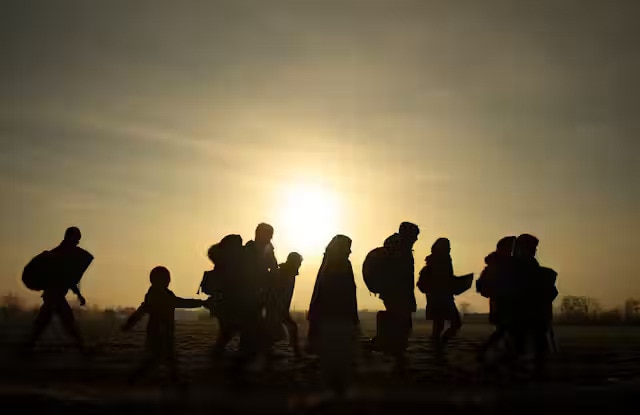The number of Indian citizens arriving in Mexico irregularly has been increasing steadily. In 2023, a year marked by a record-breaking migratory flow to the United States, Indians became the second largest group of Asian migrants crossing through Mexico, trailing only the Chinese. This trend reflects the complex and evolving migration dynamics between India, Mexico, and the United States.
Rising Numbers
In 2022, fewer than 3,000 Indian migrants were detected in Mexico. By 2023, this figure had multiplied by four, exceeding 12,400. In the first two months of 2024 alone, the National Migration Institute (INM) of Mexico had already located more than 3,300 Indian migrants passing through the country. This dramatic increase highlights a significant shift in migration patterns.
Operation in Cancun
Last month, Mexican authorities discovered 75 Indian migrants (mostly men and three women) in a hostel north of Cancun, during an operation targeting the trafficking of undocumented immigrants. The operation, conducted by state security forces and the National Guard, resulted in the arrest of one individual involved in the trafficking network. This network had been operating for over a year and a half, luring migrants from various countries, including Lebanon, Turkey, Nicaragua, and Guatemala, through digital platforms. The traffickers would confiscate the migrants’ passports and cell phones upon arrival.
Dangerous Journeys
The dangers of these migratory journeys were starkly highlighted by tragic incidents near the US-Canada border. In January 2022, a family of four Indians, including two young children, were found frozen to death near Manitoba, Canada. In March 2023, the bodies of eight migrants, including four Indians, were recovered from the San Lorenzo River in Quebec.

Indian nationals encounter at Southwest land border keeps rising, in Year 2021 (Jan-Dec), the Indian nationals encountered are 5105 as followed Year 2022 (Jan-Dec) – 23289, Year 2023 (Jan-Dec) – 43762 and Year 2024 (Jan – April) – 7121.
The Key Route
Many Indian migrants view Canada as a quicker and safer alternative for reaching the United States. The Canadian government’s push to attract international students has made it easier for Indians to obtain visas. Previously, many Indians who were denied Canadian residency would move to the US from Canada. However, an increasing number of Indians now use Mexico as a transit point to enter the US directly, seeking better job opportunities and a stronger economy. The support of the established Indian community in the US also influences their decision.
US-Canada Border Challenges
The US-Canada border, the longest international border in the world, presents its own challenges. Spanning 8,891 kilometers, the border is marked by natural barriers like the Great Lakes in some areas, but in others, especially in northeastern New York, it is flat and arid, with open fields and forests. Migrants often cross through forested areas, which can be risky, particularly during winter when temperatures can drop well below freezing.
Surging Numbers at the Northern Border
The US has seen an unprecedented surge in undocumented Indian migrants, many entering through Mexico. According to reports in the public domain, in fiscal year 2023, US border agents encountered nearly 97,000 undocumented Indian migrants nationwide, including more than 30,000 at the northern border. The record influx has overwhelmed border security officials and unsettled communities in northern US states. Between October 2023 and February 2024, nearly 14,000 Indians were encountered at the US-Canada border.

This year 2024 (Jan- April), 12167 Indian nationals encountered at the Northern land border are more as compared to Indian nationals encountered at Southwest land border. In Year 2021 (Jan-Dec) – 3382, Year 2022 (Jan-Dec) – 23289 and Year 2023 (Jan-Dec) – 43762.
Economic and Social Factors
The influx of Indian migrants is driven by various factors, including economic conditions in India. While many Indian migrants have genuine claims of persecution, experts note that most are economic migrants seeking a better life in the US. They often come from relatively prosperous states like Punjab and Gujarat, which have a long history of immigration to the United States. The lack of industrial and urban job opportunities in India, combined with high indebtedness and crop losses in the agricultural sector, compels many to seek opportunities abroad.
Charter Flights to Border Regions
A new trend has emerged in recent years where Indian migrants use charter flights to reach the nearest borders to enter the US. These migrants often fly from Gulf countries or European nations, heading directly to countries like Mexico or Canada, from where they attempt to cross into the United States. This method is seen as a quicker and sometimes safer option compared to traditional routes. Chartering flights, though expensive, allows migrants to bypass some of the more hazardous legs of the journey, but it still leaves them vulnerable to exploitation by human trafficking networks.
Costly and Dangerous Routes
For many Indian migrants, the journey to the US involves significant financial and personal risks. As reported previously in Financial Express Online, the “donkey route” across several continents, facilitated by global human trafficking networks, can cost over US$50,000. Despite the high cost and dangers, many Indians, driven by desperation and the hope of a better future, are willing to take this route.
Increasing Restrictions
In response to the growing influx of Indian migrants, countries like Canada and the UK have started imposing stricter controls. The US is also likely to implement similar measures to stem the flow of undocumented Indian immigrants.
Impact on Mexico
Interestingly, Mexico has also started deporting undocumented Americans who are looking for a lower cost of living in the country. This trend, driven by inflation in Mexico, has led to the deportation of over 240,000 migrants in 2023 alone.
The rising number of Indian migrants in Mexico and the US reflects broader global migration trends and the complex interplay of economic, social, and political factors. As countries grapple with these challenges, the need for comprehensive and humane migration policies becomes increasingly urgent.
